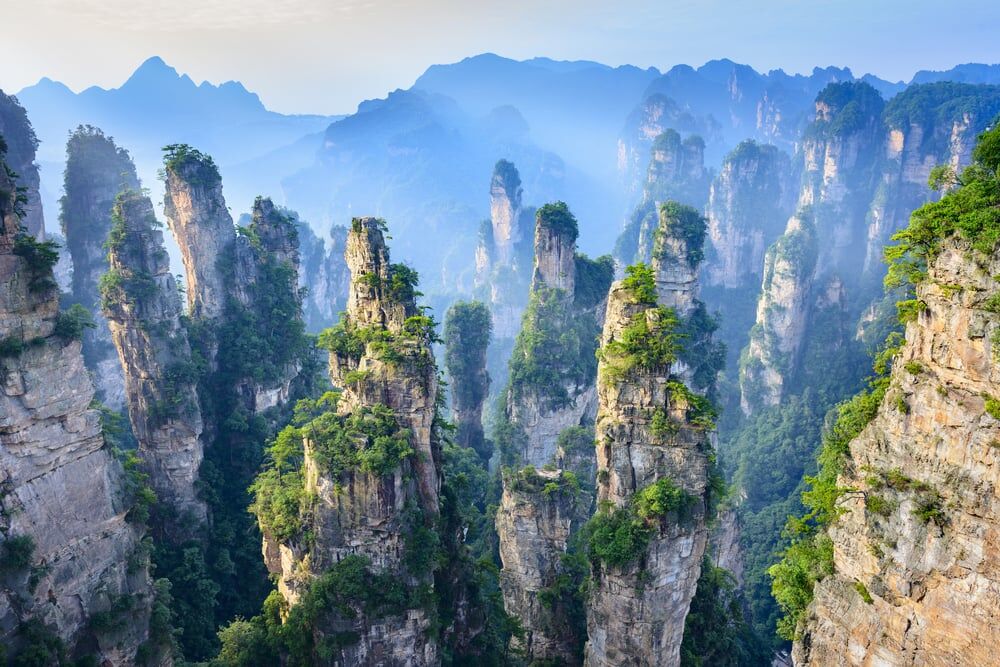
What Are the Rock Formations in Zhangjiajie?
About Zhangjiajie National Forest Park
Zhangjiajie National Forest Park is a UNESCO World Heritage Site located in the Hunan Province of China. It is a land of breathtaking natural beauty, renowned for its towering sandstone pillars, lush forests, deep canyons, and cascading waterfalls. The park covers an area of over 48 square kilometers and is part of the larger Wulingyuan Scenic and Historic Interest Area.
The Unique Geology of Zhangjiajie
The most striking feature of Zhangjiajie is its unique and dramatic landscape, characterized by thousands of towering sandstone pillars that rise from the valley floor. These sandstone formations, known locally as "stone forests," are the result of millions of years of geological processes.
Formation of the Sandstone
The story of these formations begins over 300 million years ago during the Devonian period. At this time, the area that is now Zhangjiajie was a vast inland sea. Over millions of years, layers of sand, silt, and other sediments were deposited on the seafloor, eventually forming thick layers of sandstone.
Uplift and Erosion
Around 200 million years ago, during the Jurassic period, the Earth's tectonic plates shifted, causing the region to uplift significantly. This uplift created cracks and fissures in the sandstone, providing pathways for water to seep in.
Over millions of years, the combined forces of wind, water, and ice eroded the softer layers of rock, leaving behind the more resistant quartzite sandstone pillars we see today. The process of erosion continues to shape the landscape, carving out deep ravines, caves, and natural arches.
Types of Sandstone Formations in Zhangjiajie
Zhangjiajie boasts a variety of sandstone formations, each with its unique characteristics:
| Formation Type | Description |
|---|---|
| Pillars | The most iconic formations, these are tall, slender pillars that rise vertically from the ground. |
| Cones | Similar to pillars but with a wider base and a more conical shape. |
| Towers | Larger and more massive than pillars, often with multiple peaks and summits. |
| Arches | Formed when erosion creates an opening through a sandstone wall or ridge. |
| Caves | Natural cavities within the sandstone formations, often decorated with stalactites and stalagmites. |
The Significance of Quartzite Sandstone
The specific type of sandstone found in Zhangjiajie is known as quartzite sandstone. This type of sandstone is particularly resistant to erosion due to its high quartz content. Quartz is a hard mineral that is highly resistant to weathering and erosion, allowing the pillars to withstand the elements for millions of years.
FAQ
What makes the sandstone pillars in Zhangjiajie so unique?
The combination of their height, slenderness, and sheer number makes the sandstone pillars of Zhangjiajie unique. The geological processes that created them, including uplift and erosion over millions of years, are also responsible for their unusual and dramatic appearance.
Are the rock formations in Zhangjiajie still changing?
Yes, the rock formations in Zhangjiajie are still evolving. Erosion continues to shape the landscape, albeit slowly. Factors like wind, rain, and even vegetation play a role in shaping these formations over time.
Why is Zhangjiajie a UNESCO World Heritage Site?
Zhangjiajie was designated a UNESCO World Heritage Site in 1992 for its outstanding natural beauty and its unique geological formations. The park also plays an important role in biodiversity conservation, as it is home to a wide variety of plant and animal species, many of which are rare or endangered.